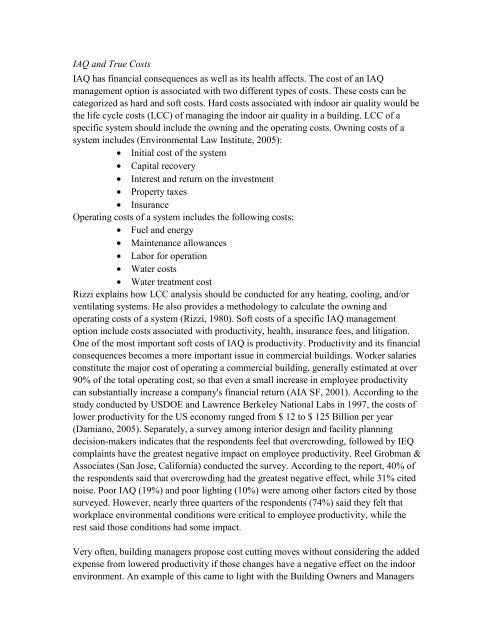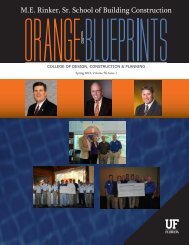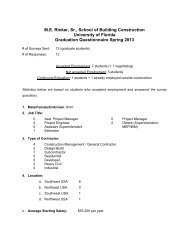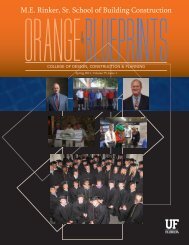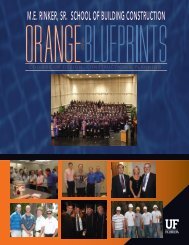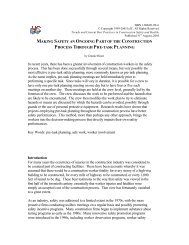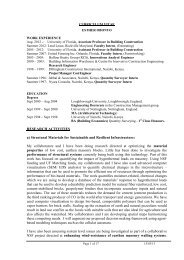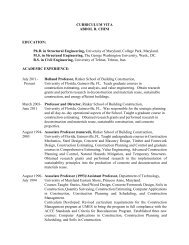Full Proposal in pdf - M E Rinker Sr School of Building Construction ...
Full Proposal in pdf - M E Rinker Sr School of Building Construction ...
Full Proposal in pdf - M E Rinker Sr School of Building Construction ...
Create successful ePaper yourself
Turn your PDF publications into a flip-book with our unique Google optimized e-Paper software.
IAQ and True CostsIAQ has f<strong>in</strong>ancial consequences as well as its health affects. The cost <strong>of</strong> an IAQmanagement option is associated with two different types <strong>of</strong> costs. These costs can becategorized as hard and s<strong>of</strong>t costs. Hard costs associated with <strong>in</strong>door air quality would bethe life cycle costs (LCC) <strong>of</strong> manag<strong>in</strong>g the <strong>in</strong>door air quality <strong>in</strong> a build<strong>in</strong>g. LCC <strong>of</strong> aspecific system should <strong>in</strong>clude the own<strong>in</strong>g and the operat<strong>in</strong>g costs. Own<strong>in</strong>g costs <strong>of</strong> asystem <strong>in</strong>cludes (Environmental Law Institute, 2005):• Initial cost <strong>of</strong> the system• Capital recovery• Interest and return on the <strong>in</strong>vestment• Property taxes• InsuranceOperat<strong>in</strong>g costs <strong>of</strong> a system <strong>in</strong>cludes the follow<strong>in</strong>g costs:• Fuel and energy• Ma<strong>in</strong>tenance allowances• Labor for operation• Water costs• Water treatment costRizzi expla<strong>in</strong>s how LCC analysis should be conducted for any heat<strong>in</strong>g, cool<strong>in</strong>g, and/orventilat<strong>in</strong>g systems. He also provides a methodology to calculate the own<strong>in</strong>g andoperat<strong>in</strong>g costs <strong>of</strong> a system (Rizzi, 1980). S<strong>of</strong>t costs <strong>of</strong> a specific IAQ managementoption <strong>in</strong>clude costs associated with productivity, health, <strong>in</strong>surance fees, and litigation.One <strong>of</strong> the most important s<strong>of</strong>t costs <strong>of</strong> IAQ is productivity. Productivity and its f<strong>in</strong>ancialconsequences becomes a more important issue <strong>in</strong> commercial build<strong>in</strong>gs. Worker salariesconstitute the major cost <strong>of</strong> operat<strong>in</strong>g a commercial build<strong>in</strong>g, generally estimated at over90% <strong>of</strong> the total operat<strong>in</strong>g cost, so that even a small <strong>in</strong>crease <strong>in</strong> employee productivitycan substantially <strong>in</strong>crease a company's f<strong>in</strong>ancial return (AIA SF, 2001). Accord<strong>in</strong>g to thestudy conducted by USDOE and Lawrence Berkeley National Labs <strong>in</strong> 1997, the costs <strong>of</strong>lower productivity for the US economy ranged from $ 12 to $ 125 Billion per year(Damiano, 2005). Separately, a survey among <strong>in</strong>terior design and facility plann<strong>in</strong>gdecision-makers <strong>in</strong>dicates that the respondents feel that overcrowd<strong>in</strong>g, followed by IEQcompla<strong>in</strong>ts have the greatest negative impact on employee productivity. Reel Grobman &Associates (San Jose, California) conducted the survey. Accord<strong>in</strong>g to the report, 40% <strong>of</strong>the respondents said that overcrowd<strong>in</strong>g had the greatest negative effect, while 31% citednoise. Poor IAQ (19%) and poor light<strong>in</strong>g (10%) were among other factors cited by thosesurveyed. However, nearly three quarters <strong>of</strong> the respondents (74%) said they felt thatworkplace environmental conditions were critical to employee productivity, while therest said those conditions had some impact.Very <strong>of</strong>ten, build<strong>in</strong>g managers propose cost cutt<strong>in</strong>g moves without consider<strong>in</strong>g the addedexpense from lowered productivity if those changes have a negative effect on the <strong>in</strong>doorenvironment. An example <strong>of</strong> this came to light with the Build<strong>in</strong>g Owners and Managers


